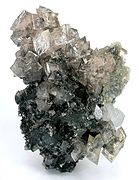利用者:Akaniji/菱亜鉛鉱
| Smithsonite | |
|---|---|
 | |
| 分類 | strunz = 05.AB.05 |
| 化学式 |
ZnCO3 symmetry = Trigonal 3 2/m unit cell = a = 4.6526(7) Å, c = 15.0257(22) Å; Z = 6 system = Trigonal - Hexagonal Scalenohedral |
| 双晶 | None observed |
| へき開 | Perfect on [1011] |
| 断口 |
Uneven, sub-conchoidal tenacity = Brittle habit = Uncommon as crystals, typically botryoidal, reniform, spherulitic; stalactitic, earthy, compact massive |
| モース硬度 | 4.5 |
| 光沢 |
Vitreous, may be pearly refractive = nω = 1.842 - 1.850 nε = 1.619 - 1.623 birefringence = δ = 0.223 - 0.227 |
| 色 |
White, grey, yellow, green to apple-green, blue, pink, purple, bluish grey, and brown diaphaneity = Translucent |
| 条痕 | White |
| 比重 | 4.4 - 4.5 |
| 光学性 | Uniaxial (-) |
| 蛍光 | May fluoresce pale green or pale blue under UV |
| 文献 | [1][2][3] |
| プロジェクト:鉱物/Portal:地球科学 | |
Smithsonite, or zinc spar, is zinc carbonate (ZnCO3), a mineral ore of zinc. Historically, smithsonite was identified with hemimorphite before it was realised that they were two distinct minerals. The two minerals are very similar in appearance and the term calamine has been used for both, leading to some confusion. The distinct mineral smithsonite was named in 1832 by François Sulpice Beudant in honor of English chemist and mineralogist, James Smithson (c.1765-1829), whose bequest established the Smithsonian Institution and who first identified the mineral in 1802.[2][4]
Smithsonite is a variably colored trigonal mineral which only rarely is found in well formed crystals. The typical habit is as earthy botryoidal masses. It has a Mohs hardness of 4.5 and a specific gravity of 4.4 to 4.5.
Smithsonite occurs as a secondary mineral in the weathering or oxidation zone of zinc-bearing ore deposits. It sometimes occurs as replacement bodies in carbonate rocks and as such may constitute zinc ore. It commonly occurs in association with hemimorphite, willemite, hydrozincite, cerussite, malachite, azurite, aurichalcite and anglesite. It forms two limited solid solution series, with substitution of manganese leading to rhodochrosite, and with iron, leading to siderite.[3]
-
Botryoidal smithsonite from Choix, Sinaloa, Mexico, 18.8 x 11.6 x 4.0 cm
-
Pink botryoidal smithsonite from Choix, 6.8 x 5.8 x 3.3 cm
-
Crystals of slightly pink cobaltoan smithsonite, Tsumeb, 6.8 x 4.6 x 3.7 cm
-
Cuprian smithsonite on dolomite, Tsumeb, 4.4 x 4 x 3 cm
See also
[編集]Bibliography
[編集]- Tom Hughes, Suzanne Liebetrau, and Gloria Staebler, eds. (2010). Smithsonite: Think Zinc! Denver, CO: Lithographie ISBN 978-0979099861.
- Ewing, Heather (2007). The Lost World of James Smithson: Science, Revolution, and the Birth of the Smithsonian. London and New York: Bloomsbury ISBN 978-1596910294
References
[編集]- ^ http://www.mindat.org/min-3688.html Smithsonite: Smithsonite mineral information and data from Mindat
- ^ a b http://www.webmineral.com/data/Smithsonite.shtml Smithsonite mineral data from Webmineral
- ^ a b http://rruff.geo.arizona.edu/doclib/hom/smithsonite.pdf Handbook of mineralogy
- ^ “Smithsonite at the National Museum of Natural History”. Smithsonian Institution. Template:Cite webの呼び出しエラー:引数 accessdate は必須です。




